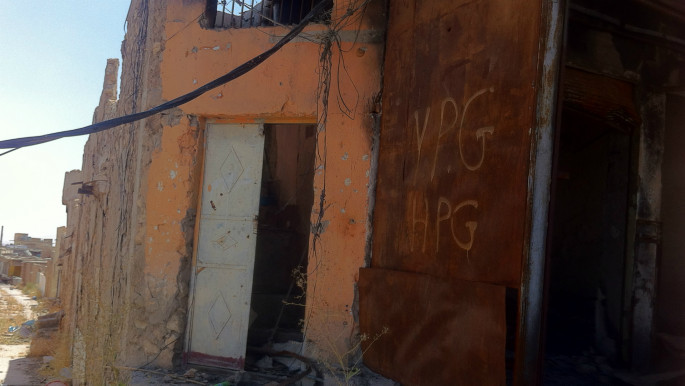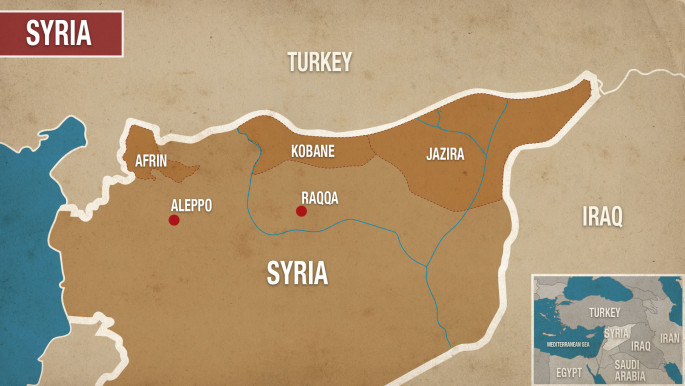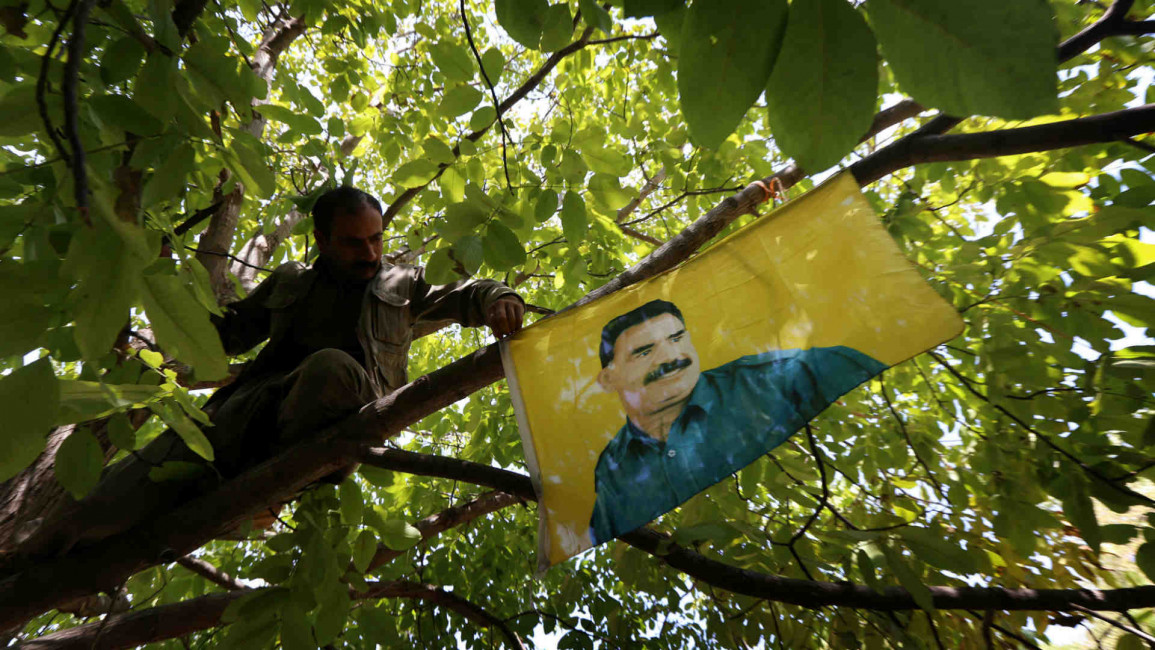
The narrowing distinctions between the PKK and its offshoots
The narrowing distinctions between the PKK and its offshoots
Comment: Under fire from all sides, armed Kurdish groups are more likely to work together, writes Paul Iddon.
6 min read
An anti-Iran PJAK fighter displays a flag of PKK leader Abdullah Ocalan [AFP]
As Turkey continues to threaten the Syrian Kurdish People's Protection Units (YPG) forces in Syria and the Kurdistan Workers' Party (PKK) fighters in the mountains of Iraqi Kurdistan, there are chances that these groups - which adhere to the same fundamental ideology but largely confine and restrict their activities to their countries of origin - will work together much more closely and openly.
Zozan Temir, a fighter with the YPG's all-female Women's Protection Units (YPJ) branch, was reportedly killed on November 15 by a Turkish airstrike near Sirnak in the country's Kurdish-majority southeast.
This incident was notable since the YPJ is based in Syria, not Turkey.
For years the YPG's political wing, the Syrian Kurdish Democratic Union Party (PYD), has sought to distinguish itself from the PKK, largely because the US has given them decisive military support in the campaign against the Islamic State group in Syria. Washington has also toed this line so as not to violate its own laws - which unequivocally designates the PKK a terrorist organisation - by arming the group against IS.
The PYD fly the same flags, profess loyalty to the PKK's imprisoned leader Abdullah Ocalan, wave flags with his face on (and more recently flew said flags on the streets of Raqqa after capturing it from IS, earning some consternation from the US in the process) and devoutly follow the group's ideology and Ocalan's pronouncements on a variety of issues.
Put simplistically, the PYD is the PKK's Syrian wing, whose primary responsibility is the promulgation of Ocalan's favoured political system - which in more recent years is Democratic Confederalism, an anarcho-socialist ideology which contends that the concept of the nation state denies true democracy and social justice.
Since the onset of the Syrian Civil War and the rise of IS, the group has had very considerable success, expanding its hold on territory across Syria and carving out a de-facto autonomous entity in northern Syria's Kurdish regions in which to implement, or experiment with, Ocalan's favoured system of governance.
Turkey wants to destroy this fledgling autonomy and dismantle the PYD/YPG. Ankara has threatened for months to invade their most isolated territory, Afrin Canton in the northwest, and has targeted the YPG intermittently with cross-border artillery bombardments and even some airstrikes.
The YPG meanwhile vows to repel any Turkish invasion of Syria's Kurdish territories. It's unclear if such an invasion could actually see them work directly with the PKK to attack the Turkish military on both sides of the border.
Temir's death also brings into question the extent of the link that exists between the PKK and PYD, as well as other groups. In 2016, the president of the Iraqi Kurdistan region, Masoud Barzani, dismissed the notion that the two groups were distinct in any way, asserting: "Any support to the PYD means support for the PKK."
In 2003, in their Qandil Mountain stronghold in Iraqi Kurdistan, the PKK, under the umbrella of the Kurdistan Communities Union (KCK), established the PYD as their Syrian wing. The group's political, and later military, activities were therefore confined exclusively to Syria. When the PKK faced a renewed, and ferocious, Turkish military campaign, which began in the second half of 2015 after the breakdown of the ceasefire and peace talks initiated in early 2013, the PYD/YPG focused entirely on their fight against IS in Syria.
The PKK and YPG openly fought together in Sinjar in neighbouring Iraq, where they saved thousands of Yazidis from IS' genocide. They still retain forces there. On a visit to Sinjar in August 2016 this journalist observed graffiti which listed the PKK's armed wing, the HPG, alongside the YPG.
PKK flags, and the flag of the Yazidi Sinjar Protection Units (YBS) group, which is also affiliated with the PKK, were present, as were YPJ fighters staffing checkpoints. True, they were allied to fight IS but were also, and remain, essentially different wings of the same force fighting together against the same enemy.
The Free Life of Kurdistan (PJAK) is another significant PKK creation. Founded in 2004, also under the KCK umbrella, it has essentially the same makeup and ideology as the PKK and PYD, strictly adhering to Ocalan's views on everything from democratic confederalism to feminism. Its purpose is to fight against the regime in Tehran in Iranian Kurdistan.
As with the PKK and PYD they are loyal to Ocalan and also display flags bearing his portrait. Before 2009 they were not designated terrorists by the US government, leading to some speculation that the US intended to take no measures against them, since they were fighting Washington's Iranian rivals and not their Turkish allies.
Over the summer, Turkish President Recep Tayyip Erdogan spoke of an Iranian-Turkish military operation to crush the PKK. He likely envisages both powers working together to target both groups and treat them as one in their mountain strongholds of Iraqi Kurdistan.
This alliance yet to materialise, although there has already been some notable cooperation between them on this issue in recent weeks. Last month Turkish warplanes bombed the Asos Mountain in Iraqi Kurdistan's Sulaimani province. Both PJAK and the PKK are reportedly based in that area, meaning that Turkey could already be killing fighters from both these, ostensibly different, Kurdish groups.
Erdogan has also claimed several times that weapons provided by the US to the PYD/YPG to fight IS (which Washington says it will try and retrieve) will be transferred to the PKK and used against Turkey.
More recently he said these groups would use this weaponry against both Turkey and Iran, underscoring his contention that the PKK, PYD and PJAK are all one and the same and threaten the wider region, not just Turkey.
In addition to invading Afrin, Erdogan has vowed to "level Qandil to the ground". Simultaneous Turkish assaults against the PKK in Qandil and PYD in Afrin could result in further direct cooperation between these groups, since they will be simultaneously fighting the same adversary.
Also, if Iranian and Turkish operations against the PKK and PJAK in Iraqi Kurdistan are ever directly coordinated, or carried out jointly, this could result in much broader and open cooperation between the two groups' hitherto separate campaigns against both powers.
In a somewhat ironic twist, Erdogan's repeated mantra that these groups are essentially one and the same may become a far more clear-cut observable reality as a direct result of the actions he takes against them.
Paul Iddon is a freelance journalist based in Erbil, Iraqi Kurdistan, who writes about Middle East affairs.
Follow him on Twitter: @pauliddon
Zozan Temir, a fighter with the YPG's all-female Women's Protection Units (YPJ) branch, was reportedly killed on November 15 by a Turkish airstrike near Sirnak in the country's Kurdish-majority southeast.
This incident was notable since the YPJ is based in Syria, not Turkey.
For years the YPG's political wing, the Syrian Kurdish Democratic Union Party (PYD), has sought to distinguish itself from the PKK, largely because the US has given them decisive military support in the campaign against the Islamic State group in Syria. Washington has also toed this line so as not to violate its own laws - which unequivocally designates the PKK a terrorist organisation - by arming the group against IS.
The PYD fly the same flags, profess loyalty to the PKK's imprisoned leader Abdullah Ocalan, wave flags with his face on (and more recently flew said flags on the streets of Raqqa after capturing it from IS, earning some consternation from the US in the process) and devoutly follow the group's ideology and Ocalan's pronouncements on a variety of issues.
Put simplistically, the PYD is the PKK's Syrian wing, whose primary responsibility is the promulgation of Ocalan's favoured political system - which in more recent years is Democratic Confederalism, an anarcho-socialist ideology which contends that the concept of the nation state denies true democracy and social justice.
 |
Since the onset of the Syrian Civil War and the rise of IS, the group has had very considerable success, expanding its hold on territory across Syria and carving out a de-facto autonomous entity in northern Syria's Kurdish regions in which to implement, or experiment with, Ocalan's favoured system of governance.
Turkey wants to destroy this fledgling autonomy and dismantle the PYD/YPG. Ankara has threatened for months to invade their most isolated territory, Afrin Canton in the northwest, and has targeted the YPG intermittently with cross-border artillery bombardments and even some airstrikes.
The YPG meanwhile vows to repel any Turkish invasion of Syria's Kurdish territories. It's unclear if such an invasion could actually see them work directly with the PKK to attack the Turkish military on both sides of the border.
Temir's death also brings into question the extent of the link that exists between the PKK and PYD, as well as other groups. In 2016, the president of the Iraqi Kurdistan region, Masoud Barzani, dismissed the notion that the two groups were distinct in any way, asserting: "Any support to the PYD means support for the PKK."
In 2003, in their Qandil Mountain stronghold in Iraqi Kurdistan, the PKK, under the umbrella of the Kurdistan Communities Union (KCK), established the PYD as their Syrian wing. The group's political, and later military, activities were therefore confined exclusively to Syria. When the PKK faced a renewed, and ferocious, Turkish military campaign, which began in the second half of 2015 after the breakdown of the ceasefire and peace talks initiated in early 2013, the PYD/YPG focused entirely on their fight against IS in Syria.
The PKK and YPG openly fought together in Sinjar in neighbouring Iraq, where they saved thousands of Yazidis from IS' genocide. They still retain forces there. On a visit to Sinjar in August 2016 this journalist observed graffiti which listed the PKK's armed wing, the HPG, alongside the YPG.
PKK flags, and the flag of the Yazidi Sinjar Protection Units (YBS) group, which is also affiliated with the PKK, were present, as were YPJ fighters staffing checkpoints. True, they were allied to fight IS but were also, and remain, essentially different wings of the same force fighting together against the same enemy.
The Free Life of Kurdistan (PJAK) is another significant PKK creation. Founded in 2004, also under the KCK umbrella, it has essentially the same makeup and ideology as the PKK and PYD, strictly adhering to Ocalan's views on everything from democratic confederalism to feminism. Its purpose is to fight against the regime in Tehran in Iranian Kurdistan.
As with the PKK and PYD they are loyal to Ocalan and also display flags bearing his portrait. Before 2009 they were not designated terrorists by the US government, leading to some speculation that the US intended to take no measures against them, since they were fighting Washington's Iranian rivals and not their Turkish allies.
 |
| Graffiti spotted among the ruins of Sinjar where the two groups fought IS [Paul Iddon] |
Over the summer, Turkish President Recep Tayyip Erdogan spoke of an Iranian-Turkish military operation to crush the PKK. He likely envisages both powers working together to target both groups and treat them as one in their mountain strongholds of Iraqi Kurdistan.
This alliance yet to materialise, although there has already been some notable cooperation between them on this issue in recent weeks. Last month Turkish warplanes bombed the Asos Mountain in Iraqi Kurdistan's Sulaimani province. Both PJAK and the PKK are reportedly based in that area, meaning that Turkey could already be killing fighters from both these, ostensibly different, Kurdish groups.
Erdogan has also claimed several times that weapons provided by the US to the PYD/YPG to fight IS (which Washington says it will try and retrieve) will be transferred to the PKK and used against Turkey.
 |
| Ankara is wary of the growing autonomy of the three Kurdish-controlled cantons in northern Syria |
More recently he said these groups would use this weaponry against both Turkey and Iran, underscoring his contention that the PKK, PYD and PJAK are all one and the same and threaten the wider region, not just Turkey.
In addition to invading Afrin, Erdogan has vowed to "level Qandil to the ground". Simultaneous Turkish assaults against the PKK in Qandil and PYD in Afrin could result in further direct cooperation between these groups, since they will be simultaneously fighting the same adversary.
Also, if Iranian and Turkish operations against the PKK and PJAK in Iraqi Kurdistan are ever directly coordinated, or carried out jointly, this could result in much broader and open cooperation between the two groups' hitherto separate campaigns against both powers.
In a somewhat ironic twist, Erdogan's repeated mantra that these groups are essentially one and the same may become a far more clear-cut observable reality as a direct result of the actions he takes against them.
Paul Iddon is a freelance journalist based in Erbil, Iraqi Kurdistan, who writes about Middle East affairs.
Follow him on Twitter: @pauliddon
Opinions expressed in this article remain those of the author, and do not necessarily represent those of The New Arab, its editorial board or staff.




